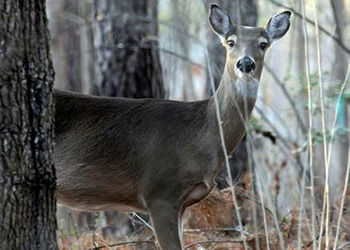Oh Deer, Have You Herd?
Oh Deer, Have You Herd?
By Site Ecology Team (SET), Wildlife and Industry Together (WAIT), Bill Willis, Bill Steinmetz, John McLamb
October 1, 2014

Courtesy of Steve McCaw
NIEHS and EPA will soon be participating in the annual SOR “Season of Rut” and we want all employees to be well informed about this special time. Mark your calendars so as not to miss any of the thrill or excitement this year. These celebrations began well before the federal government obtained this property in 1966 and are expected to continue long after we’ve retired. It’s important to be vigilant and remain safe during this period of exuberance. Although we do share our environment with the white-tail deer (Odocoileus virginianus), they are considered wilder than we and should be viewed with caution. They and we sometimes forget this important relationship on campus and allow ourselves to invade each others’ comfort zones. Let’s avoid an unfortunate situation, as some at EPA have found out.
We asked the local deer to speak on the record but they declined an interview. We offered to let them critique this piece but they refused. Therefore, the comments and observations herein are from a human’s perspective.
Deer Observations
-
Deer are native to North America and have their own food preferences (herbivores). Therefore, it is not necessary to offer food or drink to them or even plant ornamentals for their enjoyment. Their diet currently covers over 700 plants including horticultural and agricultural specimens. Acorns comprise up to 75 % of the diet locally in winter.

Doe at NIEHS entrance.
Courtesy of Steve McCaw - Deer are becoming more territorial, even showing aggression as they lose fear of man. Their range depends of how well the need for water, food, and shelter are met. Usually deer don’t migrate but stay within a 150 to 1300 acre area. Bucks (males) can exceed this range during the mating season (mid-October into November) in search of females or due to hunting pressure.
- If deer sense danger, they will raise their tail showing the white blaze, stomp the ground, and snort to warn other deer prior to taking flight. If you come upon a buck and get uncomfortably close, you may get the following series of responses; ear drop, stern look, 30 degree head and body sidle, forward movement, head lowering with antlers forward. If any of this body language happens, STOP, maintain eye contact and slowly back out of the area because a charge may be forthcoming. The does respond like the bucks to the sidle stage, but are more likely to rise up and strike out with their sharp front hooves. For your safety, at the first sign of fight vs flight, begin moving away. Turning and running may encourage being chased.
- Deer are usually most active at dusk, night, and dawn; they’re most likely to get involved in vehicle collisions then. Startled deer run into the road, get blinded, freeze, and are struck by vehicles. Both deer and human could get seriously hurt. The greatest number of fatalities happens during the mating season (deer). North Carolina’s 1.3 million deer (2013) are not evenly distributed across the state, with the Piedmont Area having the highest concentration of deer and thus deer incidents. At NIEHS/EPA, deer can be seen moving around throughout the day, so be alert.
- Even with the small deer population (10-12) on campus (covering 509 acres with EPA), deer can be harmful to the a) environment, b) man, and c) other deer.
- Being non-internet browsers, deer are opportunists and will eat leaves, twigs, and grasses. Having natural areas with native plantings helps take some pressure off ornamentals. Even overeating of native species can occur and change the ecology, thus allowing exotics to invade and get established. Habitat and food sources for other small animals could be imperiled.
- Besides causing man physical injury and possible death, deer are a host to ticks. The Deer Tick can carry Lyme disease that is spread to humans through a tick bite. Of the State’s 100 counties, at least 54 have reported cases of Lyme disease. The Piedmont region also has one of the highest incidences of Rocky Mountain Spotted Fever (Dog Tick) in the entire country. The Lone Star Tick’s bite was recently determined to cause a human allergic response to alpha-gal (sugar) and subsequently a “red meat” reaction.
- A high deer population increases habitat and food depletion that becomes detrimental to the herd. This pressure can result in poor animal nutrition, spread of disease, fawn loss, and even death. During 2012 the deer population on the east coast was significantly reduced as deer suffered from an epizootic hemorrhagic disease (EHD). The disease affecting these deer was insect borne and left deer emaciated and with internal bleeding. American Indians, wolves, and cougars helped manage herds in early America. From the 1930’s to the 1970’s, North Carolina provided deer to thirty other states due to near extinction in those areas. North Carolina also had a dramatic decrease in herd size due to hunting for meat and hides during that same period. Today the deer numbers have rebounded and in some regions are managed for the sake of man and deer alike. Hunting or culling deer herds can keep remaining animals healthier and lessen the impact to the environment.
Enjoy the Experience! Avoid Getting into a RUT
Thanks to Beth Gunn, Program Coordinator, North Carolina Wildlife Resources Commission for helpful discussion and Steve McCaw for providing NIEHS deer pictures.
Additional Information
For more information, see:



